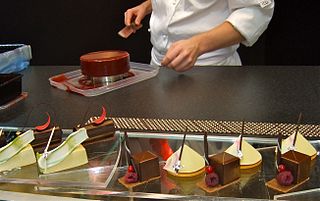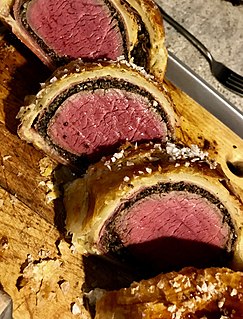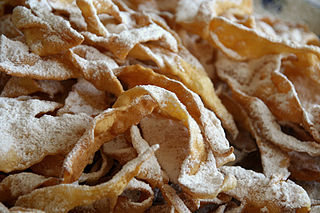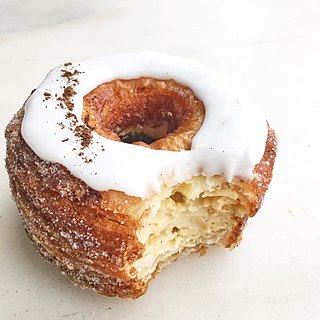| Type | Pastry |
|---|---|
| Place of origin | Tibet |
| Main ingredients | Wheat flour, butter |
In Tibetan cuisine, Yurla is a wheat pastry with butter, particularly common in Nyainrong County in northern Tibet. [1]
| Type | Pastry |
|---|---|
| Place of origin | Tibet |
| Main ingredients | Wheat flour, butter |
In Tibetan cuisine, Yurla is a wheat pastry with butter, particularly common in Nyainrong County in northern Tibet. [1]

Puff pastry, also known as pâte feuilletée, is a flaky light pastry made from a laminated dough composed of dough and butter or other solid fat. The butter is put inside the dough, making a paton which is repeatedly folded and rolled out before baking.

Pastry is a dough of flour, water and shortening that may be savoury or sweetened. Sweetened pastries are often described as bakers' confectionery. The word "pastries" suggests many kinds of baked products made from ingredients such as flour, sugar, milk, butter, shortening, baking powder, and eggs. Small tarts and other sweet baked products are called pastries. Common pastry dishes include pies, tarts, quiches, croissants, and pasties.

A pastry chef or pâtissier, is a station chef in a professional kitchen, skilled in the making of pastries, desserts, breads and other baked goods. They are employed in large hotels, bistros, restaurants, bakeries, and some cafés.

The mille-feuille, vanilla slice or custard slice, similar to but slightly different from the Napoleon, is a pastry whose exact origin is unknown. Its modern form was influenced by improvements made by Marie-Antoine Carême.

Choux pastry, or pâte à choux, is a delicate pastry dough used in many pastries. It contains only butter, water, flour, and eggs. Instead of a raising agent, it employs high moisture content to create steam during cooking to puff the pastry. The pastry is used in many European and European-derived cuisines.

Beef Wellington is a pie of English origin, made out of fillet steak coated with pâté and duxelles, wrapped in puff pastry, then baked. Some recipes include wrapping the coated meat in a crêpe or parma ham to retain the moisture and prevent it from making the pastry soggy.

A bear claw is a sweet, yeast-raised pastry, a type of Danish, originating in the United States during the mid-1920s. In Denmark a bear claw is referred to as kamme. The name bear claw as used for a pastry is first attested in 1936. The phrase is more common in Western American English, and is included in the U.S. Regional Dialect Survey Results, Question #87, "Do you use the term 'bear claw' for a kind of pastry?"

Angel wings are a traditional sweet crisp pastry made out of dough that has been shaped into thin twisted ribbons, deep-fried and sprinkled with powdered sugar. Common to many European cuisines, angel wings and have been incorporated into other regional cuisines by immigrant populations. They are most commonly eaten in the period just before Lent, often during Carnival and on Fat Thursday, the last Thursday before Lent – not to be confused with "Fat Tuesday", the day before the start of Lent. There is a tradition in some countries for husbands to give angel wings to their wives on Friday the 13th in order to avoid bad luck.

Tibetan cuisine includes the culinary traditions and practices and its peoples. The cuisine reflects the Tibetan landscape of mountains and plateaus and includes influences from neighbors. It is known for its use of noodles, goat, yak, mutton, dumplings, cheese, butter, yogurt, and soups. Vegetarianism has been debated by religious practitioners since the 11th century but is not prevalent due to the difficulty of growing vegetables, and cultural traditions promoting consumption of meat.

A pâtisserie is a type of Italian, French or Belgian bakery that specializes in pastries and sweets, as well as a term for these types of food. In both countries, it is a legally controlled title that may only be used by bakeries that employ a licensed maître pâtissier in French, meester banketbakker in Dutch, Konditormeister in German. In Dutch often the word banketbakkerij is used for the shop and banketgebak for the product.

Chebureki is a deep-fried turnover with a filling of ground or minced meat and onions. It is made with a single round piece of dough folded over the filling in a crescent shape.
In Tibetan cuisine, Tu is a cheese cake, made with yak butter, brown sugar and water, made into a pastry.
In Tibetan cuisine, Masen is a pastry, made with tsampa, dry cubic or curd cheese, yak butter, brown sugar and water.
In Tibetan cuisine, gundain is a type of pastry made from barley grain and yeast, with tsampa, dry curd cheese, wild ginseng, and brown sugar. This pastry is often served during the Tibetan New Year and Losar as a starter.

A Cronut is a croissant-doughnut pastry invented by New York City pastry chef Dominique Ansel of Dominique Ansel Bakery while working at Fauchon in France. The treat was later brought over to New York City and sold in the Dominique Ansel Bakery. The pastry resembles a doughnut and is made from croissant-like dough which is filled with flavored cream and fried in grapeseed oil. A trademark was registered for the name "cronut" at the United States Patent and Trademark Office.

Milk pie is an Indonesian custard tart pastry consisting of a shortcrust pastry filled with egg custard and condensed milk. This traditional Indonesian dessert pastry is very flat with only one very thin layer of custard. The origin of this pastry is from Bali.
| This Tibetan cuisine-related article is a stub. You can help Wikipedia by expanding it. |